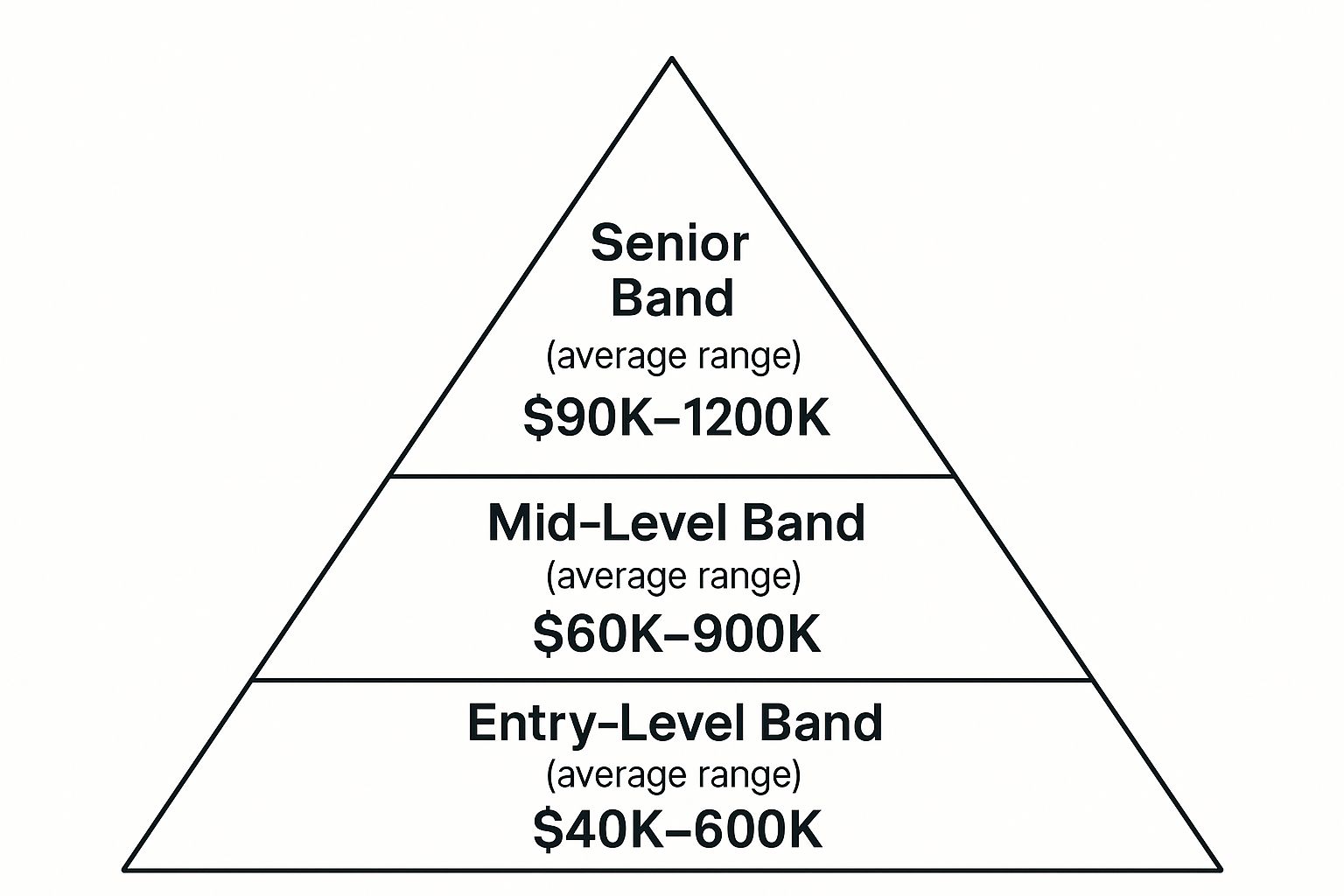Salary Bands That Work: Your Complete Strategy Guide
Understanding Salary Bands That Actually Work
Imagine chatting with a colleague about salaries. Wouldn’t it be great if everyone knew how their pay worked, what their potential earnings could be, and why certain decisions were made? That’s the magic of salary bands. They’re not just random number ranges; they’re the foundation of a fair and transparent compensation system. This approach transforms salary bands from tedious paperwork into valuable tools that build trust and open communication.
This transparency isn’t just about keeping employees happy; it’s about boosting your company’s bottom line. Organizations that use salary bands often see a big improvement in employee retention. When people feel valued and fairly compensated, they’re less likely to jump ship. This reduces those expensive recruitment costs and helps keep valuable experience within the company.
Plus, well-defined salary bands make budgeting way more predictable. By setting clear boundaries for compensation, businesses can forecast and manage labor costs more efficiently. This leads to smarter resource allocation and better financial planning overall.
Now, let’s talk about India. Salary bands here are heavily influenced by the country’s economic growth and what each industry needs. As of 2025, the average salary in India is about 358,000 INR per year (roughly 4,186 USD). But this number changes a lot based on location, industry, and experience. For example, IT and BFSI (Banking, Financial Services, and Consulting) usually pay more than other sectors. Looking at different states, places like Uttar Pradesh, West Bengal, and Maharashtra report higher average monthly salaries, with Uttar Pradesh at around 20,730 INR. These differences show how complex salary structures can be across India. Discover more insights about average salaries in India.
Regional Salary Band Variations Across Indian States
To show you how these regional variations play out, let’s look at a hypothetical example:
| Regional Salary Band Variations Across Indian States | Comparison of average salary ranges across different Indian states to illustrate regional band variations |
|---|---|
| State | Average Monthly Salary (INR) |
| Uttar Pradesh | 20,730 |
| Maharashtra | 19,500 |
| West Bengal | 18,200 |
| Karnataka | 17,000 |
This table illustrates how location and the main industries in that area affect salary expectations. Creating effective salary bands means recognizing these regional differences. A “one-size-fits-all” approach just won’t cut it in a diverse market like India. Imagine a company with offices in both Uttar Pradesh and Karnataka. They’d need to adjust their salary bands to reflect the higher cost of living and more competitive salaries in Uttar Pradesh.
Beyond regional differences, companies also have to consider internal equity. While market data is important, it’s crucial to be consistent in how you value and compensate roles within the organization. This means similar roles should fall within similar salary bands, no matter the location. This creates a sense of fairness and prevents salary gaps that could lead to unhappy employees.
By carefully balancing external market factors and internal equity, companies can design salary bands that attract and retain top talent, all while fostering a positive and productive work environment. Getting a handle on these principles is the first step toward building a compensation system that truly works.

Building Salary Bands From The Ground Up
Creating effective salary bands isn’t about copying what everyone else is doing. It’s about understanding your own organization’s specific needs and your position in the market. Let’s delve into how compensation experts design salary bands that are both competitive and make financial sense.
Imagine building a house. You wouldn’t start without a blueprint, right? Building salary bands is similar. You need a strong foundation based on job evaluations. These evaluations help you understand the actual value of each role, digging deeper than just job titles and reporting structures. They assess the skills, responsibilities, and impact of each position.
For example, a Senior Marketing Manager might have a bigger impact on revenue than a Marketing Manager, even if they report to the same person. Job evaluations capture this nuance, and the difference in impact would be reflected in their respective salary bands.
Understanding Market Dynamics
Next, we need market analysis. Think of this as checking out what similar houses are selling for in your neighborhood. It’s more than just glancing at basic salary surveys. It’s about truly understanding the compensation drivers in your specific industry. Are particular skills in high demand? Is there a shortage of experienced professionals in a certain field? These factors can significantly influence your salary bands.
Then, there’s the question of band width. This is like deciding how much room you want for expansion in your house. A narrow band (think tiny house) might not offer enough room for career growth and could discourage employees. A very wide band (like a sprawling mansion) can be hard to manage and create budget problems. The sweet spot? A band width that provides growth opportunities without overspending.

This infographic shows a simplified salary band structure with three tiers: Entry-Level, Mid-Level, and Senior. Each tier reflects a typical career path, and the salary ranges increase as responsibilities and experience grow. As you can see, someone starting in an entry-level role would ideally move upwards through the bands as they gain experience and take on more responsibility.
Avoiding Common Mistakes
Now, let’s talk about some common pitfalls. Many companies make the mistake of designing salary bands in isolation. It’s like designing a beautiful kitchen that doesn’t match the rest of the house. It might look great on its own, but it clashes with the overall design. Your salary bands need to fit with your overall compensation strategy.
Another frequent mistake? Not explaining the reasoning behind the salary bands to employees. Transparency builds trust. It’s like explaining your house design choices to your family. They might not love every decision, but understanding your rationale helps them appreciate the final result.
Finally, remember that salary bands shouldn’t be set in stone. Just like a house needs upkeep, your salary bands should be reviewed and updated regularly. This keeps your compensation system competitive and fair, addressing potential problems before they become major headaches, just like regular home maintenance prevents costly repairs down the line.
To help you build effective salary bands, let’s look at a framework of key components:
To help you navigate this process, here’s a handy framework:
Salary Band Design Framework Components
| Component | Purpose | Best Practice | Common Mistakes |
|---|---|---|---|
| Job Evaluation | Determine the relative value of each role | Use a consistent and objective methodology | Relying solely on job titles |
| Market Analysis | Understand competitive salary ranges | Use multiple data sources and consider industry specifics | Relying on outdated or generic data |
| Band Width | Define the range within each band | Balance internal equity and market competitiveness | Setting bands too narrow or too wide |
| Communication | Explain the rationale behind the bands | Be transparent and open with employees | Lack of communication or unclear explanations |
| Review and Adjustment | Keep bands current with market changes | Regularly review and adjust bands as needed | Failing to update bands, leading to inequities |
This table summarizes the essential building blocks for creating salary bands. By understanding these components and avoiding common mistakes, you can create a compensation system that attracts, retains, and motivates top talent, ultimately contributing to your organization’s success.
Balancing Market Forces With Internal Fairness

Let’s talk about how the perfect world of salary bands bumps up against real-world market conditions. Even the most well-designed salary bands can be affected by the ups and downs of the job market. Think of it like a ship navigating choppy waters.
Imagine a sudden surge in demand for software developers. Salaries skyrocket, and your carefully planned salary bands suddenly feel too low. On the other hand, an economic downturn might force cost-cutting, making it tough to maintain existing salaries. So, how do you steer through these challenges without throwing your salary structure overboard or losing the crew’s (your employees’) trust?
One common issue is talent scarcity. Picture a tech company desperately seeking skilled developers in a competitive market. Sticking rigidly to existing salary bands might mean missing out on the best candidates.
In these situations, some companies tweak specific bands. This ensures they stay competitive while keeping things fair internally. This could mean widening the band for high-demand roles or adding specific allowances for certain skills.
The Indian job market offers a good example of these dynamic salary trends. Salary bands in India are also affected by gender disparities. The projected average annual salary for men in 2025 is about ₹1,953,055, while for women it’s around ₹1,516,296. This difference highlights the need for fair salary practices across genders. Interestingly, the Indian job market also anticipates significant salary growth overall, with a predicted rise of 9.5% according to the WTW Salary Budget Planning Report. This suggests a positive outlook for salary growth across different sectors and demographics, despite existing disparities. Want to learn more? Check out average salaries in India: Find out more about average salaries in India.
Adapting to Economic Fluctuations
Economic downturns bring their own set of problems. When cost-cutting is unavoidable, some companies resort to blanket salary freezes or reductions. This can hurt morale and create unfairness.
A better strategy? Carefully review and adjust salary bands, considering factors like performance, the importance of different roles, and your long-term talent strategy. This makes sure essential roles are still paid appropriately while managing overall costs. For some extra insights, take a look at: 5 Best Practices for Assessing and Hiring a Culture Fit Candidate.
Maintaining Transparency and Communication
The key to managing these changes is clear and honest communication. When salary bands need adjusting, explain the reasons to your employees. This builds understanding and acceptance, avoiding resentment and confusion.
Transparency builds trust and shows your employees that you value them. Imagine a company explaining how market forces are affecting salary bands and outlining the steps they’re taking to maintain fairness and competitiveness. This creates a shared understanding and strengthens the relationship between employer and employee.
Balancing Exceptional Performers and Equity
Another important point is balancing rewards for top performers with overall fairness within the salary band structure. While it’s important to recognize high achievers, going over band maximums can create pay gaps and weaken the structure.
Successful organizations develop strategies to handle this, like performance-based bonuses, equity grants, or career development opportunities that align with higher compensation levels in other bands. This keeps the salary band system consistent while still recognizing and rewarding outstanding performance.
Rolling Out Salary Bands Without Creating Chaos
Imagine you’re planning a major home renovation. You could demolish everything at once, creating chaos, dust, and stress. Or, you could strategically phase the project, minimizing disruption. Rolling out salary bands is similar. A well-planned approach makes all the difference. We’ll explore how to sequence the rollout, communicate transparently, manage employee reactions, and share proven tactics from HR leaders who’ve done it successfully.
Sequencing the Rollout for Minimal Disruption
Think of a phased rollout like renovating one room at a time. Start with a pilot group, perhaps a specific department or location. This allows you to test the system, gather feedback, and address any issues before a company-wide launch. It’s also a great opportunity to train managers and refine your communication approach.
Communicating Transparently and Managing Expectations
Imagine your contractor not telling you what to expect during renovations. Frustrating, right? Employees need clear and consistent communication throughout the salary band implementation. Explain the why – the benefits for both them and the organization. Be upfront about potential adjustments and address concerns proactively. Transparency builds trust and reduces anxiety.
Addressing Employee Reactions and Concerns
Change can be unsettling. Some employees might be excited about the new salary bands, while others may feel confused or worried. Address these reactions proactively. Create opportunities for open dialogue, answer questions honestly, and provide support. This might involve individual meetings, group sessions, or even anonymous feedback channels. You might be interested in: Tips on How to Reduce Candidate Offer Dropout Rate.
Timeline Considerations for a Smooth Transition
A rushed implementation, like a rushed renovation, can lead to hidden problems. Allow ample time for each phase – from job evaluations and market analysis to communication and training. A realistic timeline is essential for a smooth transition.
Real-World Implementation Stories and Best Practices
Learning from others is invaluable. We’ll share real implementation stories, highlighting what worked, what didn’t, and the lessons learned. For example, one organization realized their initial communication was too technical, leaving employees confused. They simplified their language and used real-life examples, significantly improving understanding and acceptance.
Handling Specific Employee Situations
What if an employee’s current salary falls outside the new salary band? How do you address those who feel their career progression is unclear? We’ll offer guidance on handling these sensitive situations with empathy and fairness. For example, if an employee is below the minimum of their new band, you could create a plan to bring them up to the minimum over time, based on performance.
Practical Tools and Templates
To simplify your implementation, we’ll provide templates for announcements, FAQs, and manager training materials. These tools, proven effective in real-world settings, can save you time and ensure consistency. Think of it like having a blueprint for your renovation, complete with material lists and instructions.
Stakeholder Engagement and Training
Successful implementation requires buy-in. Engage senior management, HR, and department heads early on. Train managers on how to communicate the changes and address employee questions. This shared understanding ensures everyone is on the same page.
Measuring Implementation Success Beyond the Rollout
Implementation isn’t just about launching the new salary bands; it’s about ensuring they’re effective long-term. We’ll discuss key metrics to track, such as employee satisfaction, internal equity, and the impact on recruitment and retention. This ongoing monitoring allows for adjustments and optimization, ensuring your system continues to support your organization’s goals.
Using Salary Bands As Strategic Talent Tools

Smart companies understand that salary bands are more than just a way to calculate payroll. They’re a vital tool for managing talent. Think of them like a career map for employees, showing their current position and potential paths for growth and higher earnings within the company. This kind of transparency makes a huge difference in attracting, motivating, and retaining talented individuals.
Attracting and Retaining Top Talent With Transparency
Imagine two companies with similar job openings. One keeps salaries secret, the other openly shares its salary bands. Which is more appealing to candidates who value clarity and fairness? The transparent approach builds trust right from the start, laying the groundwork for a strong employer-employee relationship. You might be interested in this article on compensation strategies: How to Use Creative Compensation to Boost Your Recruiting.
Surprisingly, open communication about salary bands often boosts employee satisfaction rather than fueling pay envy. When everyone understands the earning potential within their role and the steps for advancement, it eliminates guesswork and reduces the uncertainty that can push employees to seek other opportunities.
Using Salary Bands in Performance and Succession Planning
Salary bands also contribute significantly to performance discussions and succession planning. They provide a framework for productive conversations about career progression and future earnings. During performance reviews, managers can use the bands to visually demonstrate how improved performance translates to salary increases, giving employees a concrete goal to strive for and a sense of control over their career path.
In succession planning, salary bands are invaluable for identifying potential successors and crafting development plans that prepare them for leadership roles. By aligning individual career goals with the organization’s long-term talent needs, companies can ensure a smooth transition of leadership and expertise.
Integrating Salary Bands With Diversity and Inclusion Initiatives
Progressive organizations are now linking salary bands to their diversity and inclusion (D&I) initiatives. This proactive strategy addresses systemic pay gaps and creates more equitable opportunities for advancement. Analyzing salary data within each band helps companies identify disparities based on gender, ethnicity, or other factors, enabling them to take concrete steps toward a fairer and more inclusive workplace.
Real-World Examples of Strategic Band Implementation
One company, after discovering a gender pay gap within a specific salary band, took action to close it. By addressing the issue and implementing targeted interventions, they not only rectified the disparity but also strengthened employee trust and reinforced their commitment to D&I. This example highlights how salary bands can be more than just administrative tools – they can be strategic assets that advance broader organizational goals.
Another company effectively used salary bands in career development conversations. By showing employees how their current role fits into the overall compensation structure and outlining possible paths for advancement, they empowered their workforce to take ownership of their career growth. This, in turn, helped reduce employee turnover.
By shifting the perception of salary bands from purely administrative to strategically important, companies can fundamentally change how they attract, retain, and motivate their workforce. This fosters a culture of transparency, fairness, and opportunity, where every employee understands their value and potential. Ultimately, this approach strengthens the company’s ability to compete for talent and cultivates a more engaged and productive team.
Optimizing and Evolving Your Salary Band System
Once your salary bands are in place, the real work begins. It’s like building a house – you’ve laid the foundation, but now you need to furnish it, maintain it, and maybe even add a room or two as your family (or company) grows. Maintaining a relevant and effective salary band system requires a strategic, ongoing approach.
Conducting Meaningful Band Reviews
Regular reviews are essential. But these aren’t just about tweaking numbers. Think of it like a health check-up for your compensation system. Are your bands still competitive? Are they fair to employees at different levels? Are they helping you attract and retain the talent you need? These reviews should lead to real improvements, not just superficial adjustments.
For example, imagine you discover your entry-level marketing band is below market value. This insight could lead you to adjust the band upward, ensuring you stay competitive in attracting new marketing grads.
Leveraging Data Analytics for Performance Insights
Data analytics is your secret weapon. By analyzing compensation data, you can spot potential issues before they become major problems. Think of it like a car’s dashboard – warning lights alert you to potential issues before a major breakdown. For instance, a high turnover rate within a specific band might indicate a problem with its competitiveness or internal equity.
Data can also reveal broader market trends. Are specific skills suddenly in high demand? This information lets you proactively adjust your salary bands, ensuring you remain competitive and attract top talent.
Evolving Your System to Support Business Changes
Your business is dynamic, and your salary band system needs to adapt. Imagine your company expands into a new country or restructures its sales team. These changes likely require adjustments to your bands to reflect new roles, locations, and market realities. Your salary bands need to be as agile as your business.
Integrating Bands With Broader Compensation Strategies
Leading companies don’t treat salary bands in isolation. They integrate them with performance reviews, bonus programs, and long-term incentives. Think of it like a well-balanced meal – each component contributes to a healthy and satisfying whole. This creates a cohesive compensation strategy that connects individual performance with company goals.
For instance, you might link performance ratings to salary progression within a band. High performers could move more quickly through the range, while others might progress more slowly.
Metrics for Measuring Band Effectiveness
How do you know if your bands are working? Key indicators include employee satisfaction, internal equity, and your success in hiring and retaining employees. By tracking these metrics, you can assess the effectiveness of your system and find areas for improvement. Regular monitoring ensures your salary bands remain a valuable asset for your organization’s growth.
Your Complete Salary Band Action Plan
Imagine planning a road trip. You wouldn’t just hop in the car and go, right? You’d map your route, plan your stops, and pack accordingly. Building a salary band system is similar. It needs a structured approach, a roadmap, and this action plan provides just that.
Phase 1: Assessment and Planning (Timeline: 2-3 Months)
This initial phase is all about understanding your starting point and your destination. Think of it as checking your car’s vitals and choosing where you want to drive.
- Current State Analysis: Begin by evaluating your current compensation practices. Where are the inconsistencies? What’s causing headaches? This analysis establishes a baseline to measure future improvements.
- Market Benchmarking: Next, research salary trends in your industry and location. What are your competitors paying for similar roles? This ensures your salary bands are competitive and attractive to talent.
- Defining Objectives: What do you hope to achieve with your salary bands? Better employee retention? More fairness and equity? Clearer career paths? Defining your goals upfront guides your decisions moving forward.
- Resource Allocation: Finally, determine the resources required – time, budget, tools like Salary.com, and expertise – for successful implementation.
Phase 2: Design and Development (Timeline: 3-4 Months)
This is where you start building the actual salary bands, like plotting your route on a map, choosing the best roads to get to your destination.
- Job Evaluation: Assess the value of each role within your organization. Consider factors like required skills, responsibilities, and impact on the business.
- Band Structure Design: Determine the number of bands you need, the range within each band (its “width”), and the criteria for placing roles within each band. Think about career progression and market competitiveness here.
- Policy and Procedure Development: Create clear guidelines for how the salary bands will be administered. This includes processes for promotions, salary adjustments, and handling exceptions.
Phase 3: Implementation and Communication (Timeline: 2-3 Months)
This is where you put your plan into action – like starting your engine and hitting the road.
- Pilot Program: Before a company-wide launch, test your salary bands with a small group. This allows you to catch any unexpected bumps in the road and gather feedback.
- Communication Strategy: Develop a comprehensive communication plan to explain the new system to your employees. Transparency is key. Clearly explain the rationale behind the changes and proactively address any concerns.
- Training and Support: Train managers on how to use the new salary bands effectively and provide ongoing support to employees who have questions.
Phase 4: Ongoing Optimization (Timeline: Ongoing)
Like regular car maintenance, your salary bands need ongoing attention to stay effective.
- Regular Reviews: Periodically review your salary bands to ensure they remain competitive and aligned with market conditions. The market is always changing, so your salary bands need to adapt too.
- Data Analysis: Track key metrics like employee satisfaction, internal pay equity, and retention rates. This data provides valuable insights for continuous improvement.
- Continuous Improvement: Based on the data, feedback, and evolving business needs, adjust your salary band system as needed. This ensures your compensation system remains a valuable tool for attracting and retaining top talent.
Ready to build a robust and effective compensation system? Taggd can help. Our Recruitment Process Outsourcing services provide expert guidance and support, making your salary bands a strategic asset for attracting and retaining talent. Visit us at https://taggd.in to learn more.
